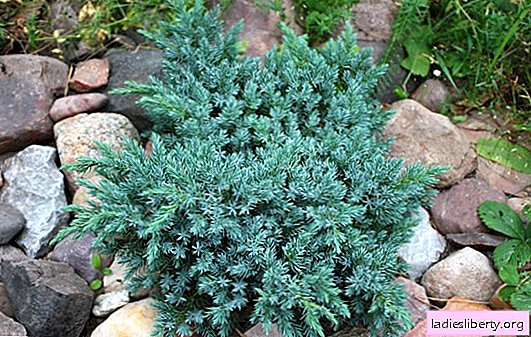
Juniper bushes are often used as an element of landscape design. This culture looks great all year long. In addition, this culture is used as a medicinal plant.
Planting dates, location and preparation of the site for juniper planting
It is customary to plant this plant in early spring, it is not necessary to wait for the onset of warm weather. After the snow melts, you can already plant it.
Occasionally, planting is done later, but in this case, the rays of the sun can burn needles.
In the fall, it is undesirable to plant juniper, the root system will not be able to take root before the cold. But if you purchased a seedling in a pot, then it can be planted at any time, you just need to protect it from direct sunlight during the day and provide good care.
Juniper grows well in an open place, where it is well lit by the sun. Often, its decorative qualities (the density of the crown and its splendor) directly depend on the amount of light.
The soil on the site for the plant needs to be prepared taking into account the purchased type of juniper. For example, ordinary juniper grows better on alkaline soil, it is also suitable for the Central Asian and Cossack varieties.
On acidic soil for these junipers it is necessary to carry out liming. The remaining species of this plant prefer acidic soil (the soil can be acidified by adding a mixture of sand, wood shavings and peat in a ratio of 1: 1: 1).
Siberian juniper, planting and caring for it is best done in light sandy soil, clay species with a good compost is better for the Virgin variety. Do not forget to create a good drainage layer for the plant. It is made of crushed stone, fragments of brick, coarse sand or pebbles, 20-25 cm thick.
It is best to plant plants purchased in 5 liter containers. They are easier to transplant and they quickly take root in a new place.
The best option for planting in open ground are plants purchased in containers with a capacity of up to 5 liters. Such instances are easier to transplant, in addition, they take root more quickly.
You can use adult plants instead of young plants, they are dug out together with a lump of earth and cover the root system with a film or burlap.
Very large specimens are undesirable. They have a long rod root that cannot be removed from the ground without damage.
Damage to the juniper roots can lead to the death of the bush. An earth lump must be soaked in water for 2 hours before transplantation.
Juniper propagation methods
Getting seedlings from seeds

Basically, all varieties of juniper are propagated using cuttings, but some species of this culture can be sown with seeds.
Seed is obtained from plants older than two years. Seed collection is made after the berries on the bushes begin to darken. But they have not yet begun to completely change their color.
After this, the embryos in the seeds go into hibernation, and their germination will require a lot of time and effort.
The grains are stratified before sowing, for this they are placed in a box in which a mixture of moss, coarse sand and peat is covered. He is taken outside and left for the winter. In May, the juniper seeds are removed from the substrate and planted in open ground.
Juniper cuttings

Propagation of this plant by cuttings is more effective than sowing seeds. To do this, in the spring, choose a healthy and strong plant, from which last year's shoot is cut together with part of the parent plant. The size of the handle is 10 cm, needles are removed from it and soaked for a day in a growth stimulator. Occasionally, the film is opened and the cuttings are allowed to “breathe”. It is necessary to constantly control the humidity of the substrate, not allowing it to dry out. After 1-2 months, roots form on the cuttings, and then they can be planted in a permanent place.
Juniper, planting and plant care, sequence of work
1. First of all, at the place where the plant will be planted, dig a hole in which the root system of the plant will fit. For young seedlings, a hole with a depth of 0.5 m is suitable. The dimensions of the planting hole should be 2-3 times larger than the earthen lump of the plant;
2. A drainage layer is poured onto the bottom, its thickness should be 20-25 cm;
3. The voids are filled with garden soil;
4. When planting, the root is carefully straightened without leaving bent roots and without injuring it. The root neck is placed at ground level, in adult plants the neck should be 7-12 cm above the soil surface;
5. Having filled the hole and rammed the soil, the planted seedling is well watered;
6. After planting, the plant is mulched, for this, rotted cones, pine bark, old sawdust or peat, sawdust are suitable. The mulch layer should be 10 cm thick.

The distance between small plants should be approximately 50 cm, between large bushes it is necessary to leave a free space of 1.5-2 m.
Juniper Care
The majority of juniper varieties tolerate drought and can not be watered for a long period, but in extreme heat it is nevertheless necessary to water the plants at least once a month. Good for juniper and spraying from the spray, this must be done in the morning 1 time per week.
In the spring, plants are fed with a nitroammophos, and 45 g of fertilizer are applied per 1 m². In warm time, the bushes can be fed with organic or mineral compounds, but this feeding is often not necessary once a month.
Juniper is negative for transplants, for this reason this can only be done as a last resort. Adult plants root with great difficulty in a new place and often die after transplantation. But if necessary, transplant a bush, choose a convenient place and prepare nutritious soil.
Junipers do not need regular pruning. But the old heavily overgrown juniper needs to be updated by cutting sick, broken branches and dry shoots. Thanks to pruning, it is easy to give the plant a beautiful shape, just keep in mind that it is not recommended to prune many branches at once, otherwise the bush may become sick.
For the winter period, young plants must be covered so that they are not damaged by low temperatures. Adult plants do not need to be hidden under shelter, they are only pulled together with a rope so that they do not break off during heavy snowfall.
In spring, most varieties of juniper receive burns from aggressive sunlight. In spring, the sun can literally burn the crown, sometimes this will not only worsen their appearance, but can also destroy individual bushes.
Even if such a plant survives and recovers, then its needles will acquire a brown-brown or yellow color.
For this reason, in February-March, the branches of plants must be covered with some kind of opaque material (for example, burlap can be used for this). After the snow melts, the shelter is removed, the soil near the plant is cleaned of last year's mulch and other debris, loosened, allowed to ventilate a bit and mulched again.











